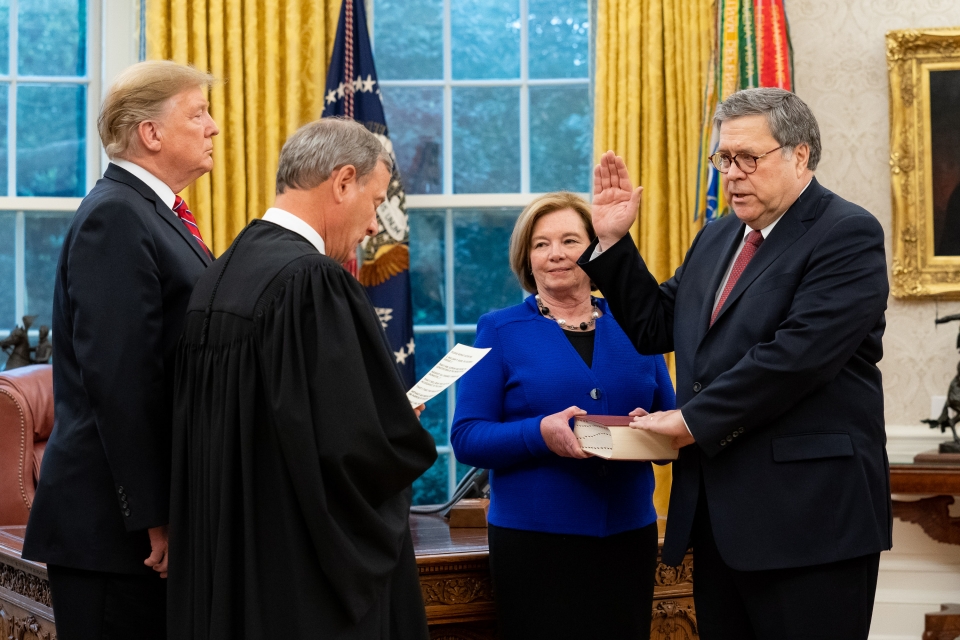Barr’s four-page letter perfectly fits America’s attention span
BALTIMORE – As everybody knows, we Americans have no attention spans whatsoever. Our national attention span was sawed off by years of TV news relentlessly giving us 15-second stories, by decades of 30-second commercial spots, and by 140-character tweets serving as comprehensive presidential insights.
And now we have this latest example, with the attorney general of the United States, William Barr, sprinting through all of 48 hours to give us a summary of what took Special Counsel Robert Mueller’s team of 19 attorneys and 40 FBI agents, who issued 2,800 subpoenas and 500 search warrants while interviewing 500 witnesses, roughly two years to complete in utter secrecy.
Maybe Barr needed to release his four-page letter while he still had our attention.
After all, Mueller handed Barr his report last Friday, and by Sunday we still didn’t know anything Mueller had given him. Who feels like waiting so long? After all, we’re busy people with so many other pressing concerns. For instance, we’re in the middle of basketball’s March Madness. And nearly as important, the cable news stations were running out of empty conjecture to fill their endless, unforgiving hours.
So it’s possible one or two nuances may have been lost in the letter that Barr released to an impatient public 48 hours after receiving two years’ worth of criminal investigation.
The Barr letter is so terse, and so truncated, that it contains only a handful of direct quotations from the Mueller report itself – thus allowing Democrats to allege a certain, shall we say, cherry picking effort by Barr (who, by the way, did not consult with Mueller before issuing his letter of summation.)
The part that Republicans are quoting, as they strut about claiming vindication of President Trump, is the line about no criminal indictments because the Mueller probe “did not establish that members of the Trump campaign conspired or coordinated with the Russian government in its election interference activities.”
The part that the Democrats are quoting, as they attempt to console themselves that Trump isn’t being led away in handcuffs, is another line, regarding obstruction of justice: that while the Mueller report “does not conclude the president committed a crime – it also does not exonerate him.”
Naturally, this did not stop the White House spokesperson, Sarah Huckabee Sanders, from immediately issuing a statement declaring, “total and complete exoneration” – precisely what the Mueller report did NOT say.
Nor did it stop President Trump, speaking for himself as he headed back to Washington from a weekend of golf in Florida, from proclaiming, “complete and total exoneration…complete exoneration” – again, precisely what the Muller report did NOT say.
And why not issue such naked contradictions? Our attention spans are so short, we’ll latch onto the first, most easily digestible thing we hear, whether it’s Barr’s four-page letter, or Trump’s statement, which lasted less than a minute.
These will now be pounded into our heads repeatedly over weeks and perhaps months before any of the promised congressional hearings uncovering details we’ve yet to learn.
In the meantime, here’s something to keep in mind about perspective. Over the course of Mueller’s investigation, half a dozen close Trump associates were either indicted or convicted, and 25 Russian intelligence operative indicted.
If all of these had happened now – at the conclusion of the investigation, rather than over the course of two years – would the impact have been greater, and the sense of national outrage more palpable?
We’ll never know. Mueller didn’t wait until the end of his work to start implicating people. Maybe he knew America didn’t have the attention span to wait that long.

Michael Olesker, columnist for the News American, Baltimore Sun, and Baltimore Examiner has spent a quarter of a century writing about the city he loves.He is the author of several books, including Michael Olesker’s Baltimore: If You Live Here, You’re Home, Journeys to the Heart of Baltimore, and The Colts’ Baltimore: A City and Its Love Affair in the 1950s, all published by Johns Hopkins Press.

